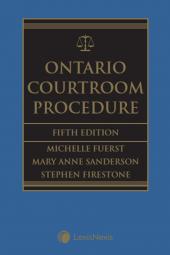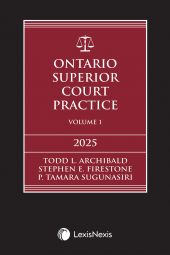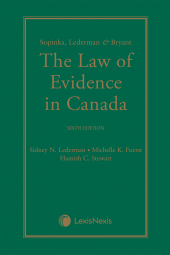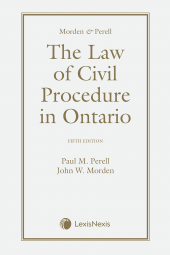Ontario Courtroom Procedure, 5th Edition – Student Edition
**This title is to be purchased by students only**
This book contains expert interpretation and commentary on the most current developments in the law. The procedural aspects of all aspects of a criminal, civil or family trial – from the pre-trial stage to the verdict and sentencing – are covered. This is a student edition.
One Year Subscription Only Terms
Subscribers receive the product(s) listed on the Order Form and any Updates made available during the annual subscription period. Shipping and handling fees are not included in the annual price.
Subscribers are advised of the number of Updates that were made to the particular publication the prior year. The number of Updates may vary due to developments in the law and other publishing issues, but subscribers may use this as a rough estimate of future shipments. Subscribers may call Customer Support at 800-833-9844 for additional information.
Subscribers may cancel this subscription by: calling Customer Support at 800-833-9844; emailing customer.support@lexisnexis.com; or returning the invoice marked 'CANCEL'.
If subscribers cancel within 30 days after the product is ordered or received and return the product at their expense, then they will receive a full credit of the price for the annual subscription.
If subscribers cancel between 31 and 60 days after the invoice date and return the product at their expense, then they will receive a 5/6th credit of the price for the annual subscription. No credit will be given for cancellations more than 60 days after the invoice date. To receive any credit, subscriber must return all product(s) shipped during the year at their expense within the applicable cancellation period listed above.
Product description
**This title is to be purchased by students only**
Click here for the professional edition of Ontario Courtroom Procedure, 5th Edition.
Conveys the "unwritten rules" of courtroom procedure
One of the most daunting facts about Ontario trial procedure is the enormous body of tradition and unwritten rules. The fifth edition of Ontario Courtroom Procedure contains expert interpretation and commentary on the most current developments in the law. The procedural aspects of all aspects of a criminal, civil or family trial – from the pre-trial stage to the verdict and sentencing – are covered.
Build your courtroom confidence with knowledge and experience distilled from leading judges and counsel, plus these time-saving features:
- Checklists to help you prepare for a trial, select a jury, hold a trial management conference, and much more
- Forms that can be completed during a trial, including forms to track criminal and civil jury selection
- Sample scripts for counsel, judges, and court staff for virtually every courtroom procedure
Ontario Courtroom Procedure, 5th Edition is the only resource to comprehensively address procedural issues in all three areas of law – criminal, civil, and family.
Practical advice and guidance for all stages of a trial
- How do you prepare and argue an application or a motion in civil and criminal cases?
- How do you select a jury in a civil or criminal case?
- What should an opening address include in civil and criminal cases?
- What can you do to facilitate the presentation of evidence in the case in chief?
- What does an effective cross-examination involve?
- How can you best use demonstrative aids?
- What content is appropriate for closing submissions?
What's New in This Edition
- Every chapter updated, including references to statutes, Rules, case law and Practice Directions
- Addition of the Statement of Principles on Self-Represented Litigants and Accused Persons
- Application of the Supreme Court of Canada Jordan framework respecting the right to trial within a reasonable time
- Amendments to the Criminal Code respecting elections and preliminary trials
- Amendments to Rule 76 – Simplified Procedure, in force as of January 1, 2020
- Amendments to the jury selection process, including determination of challenges for cause by judges alone and the abolition of peremptory challenges
- Determination of the constitutionality and retroactive application of the above amendments by the Ontario Court of Appeal in R. v. Chouhan, [2020] O.J. No. 241
- Amended Family Law Rules regarding expert witnesses, including provision for joint litigation and court-appointed experts
- Appropriate procedure if a sentencing judge wishes to depart from a joint submission as per R. v. Anthony-Cook, [2016] S.C.J. No. 43
The go-to manual for:
- Civil litigators, criminal and family practitioners who need a reference source that covers courtroom procedures from routine to rare
- Judges who need a practical text covering courtroom issues that arise every day
- Law school faculty who want to incorporate courtroom procedures into courses on trial advocacy
- Paralegals and court tribunal agents who want to learn how a trial unfolds
- Articling students who want to prepare to appear in court
Table of contents
PART 1 — THE TRIAL SYSTEM IN ONTARIO
PART 2 — LITIGANTS AND COUNSEL
PART 3 — THE LANGUAGE OF THE TRIAL
PART 4 — PREPARATION FOR TRIAL
PART 5 — ARRIVING AT COURT
PART 6 — GENERAL PROCEDURES AT TRIAL
PART 7 — MOTIONS
PART 8 — STARTING THE TRIAL
PART 9 — JURY TRIALS
PART 10 — PRESENTING EVIDENCE
PART 11 — RESPONDING TO THE EVIDENCE
PART 12 — CLOSING THE CASE
PART 13 — DECIDING THE CASE
PART 14 – CHECKLISTS
PART 15 – FORMS
PART 16 – APPENDICES
PART 17 – ETHICAL RULES AND GUIDELINES
PART 18 - STATUTORY PROVISIONS RELATING TO USING DOCUMENTS AT TRIAL AND JURIES
 Lexis Nexis
Lexis Nexis 



